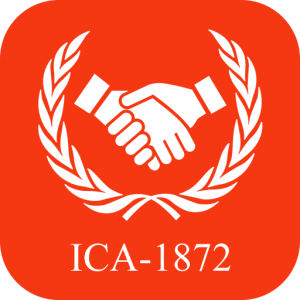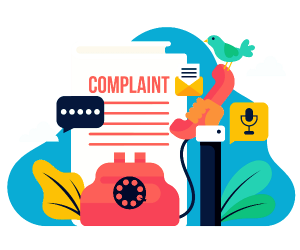
CONSUMER FORUM AND E-COMMERCE
By – MEGHA MALHOTRA
E-commerce (electronic commerce) is the buying and selling of goods and services, or the transmitting of funds or data, over an electronic network, primarily the internet. These business transactions occur either as business-to-business (B2B), business-to-consumer (B2C), consumer-to-consumer or consumer-to-busines. The terms e-commerce and e-business are often used interchangeably. The term e-tail is also sometimes used in reference to the transactional processes for online shopping. Not only have the traders benefitted from transgressing territorial boundaries for the sale of their products, the consumers of goods and services have been provided with such advantages like multiple choices, convenient delivery services, quality goods at competitive prices etc. Internet has thus revolutionized the way Indians and the rest of the world buy and sells their products.
On one hand online shopping portals like Flipkart and Amazon ensure numerous options for a wide range of goods online with quick and effective delivery systems, on the other hand , online operations are undertaken by Indian Railways, State Electricity Boards , banks , movie theatres etc for payment and booking purposes. Thus the feasibility of operations that online transactions have brought about to the Indian trade industry and other transactions is remarkable. However, the sad reality on the other side of the coin is that even with such increased scope, there is a disadvantage of entering into such online transactions, being the ambiguity in the laws relating to them.
TYPES OF E-COMMERCE
Business-to-business (B2B) e-commerce refers to the electronic exchange of products, services or information between businesses rather than between businesses and consumers.
Business-to-consumer (B2C) is the retail part of e-commerce on the internet. It is when businesses sell products, services or information directly to consumers. The term was popular during the dot-com boom of the late 1990s, when online retailers and sellers of goods were a novelty.
Consumer-to-consumer (C2C) is a type of e-commerce in which consumers trade products, services and information with each other online. These transactions are generally conducted through a third party that provides an online platform on which the transactions are carried out.
Consumer-to-business (C2B) is a type of e-commerce in which consumers make their products and services available online for companies to bid on and purchase. This is the opposite of the traditional commerce model of B2C.
A popular example of a C2B platform is a market that sells royalty-free photographs, images, media and design elements, such as iStock. Another example would be a job board.
Business-to-administration (B2A) refers to transactions conducted online between companies and public administration or government bodies. Many branches of government are dependent on e-services or products in one way or another, especially when it comes to legal documents, registers, social security, fiscals and employment. Businesses can supply these electronically. B2A services have grown considerably in recent years as investments have been made in e-government capabilities.
Consumer-to-administration (C2A) refers to transactions conducted online between individual consumers and public administration or government bodies. The government rarely buys products or services from citizens, but individuals frequently use electronic means in the following areas:
• Education: disseminating information, distance learning/online lectures, etc.
• Social security: distributing information, making payments, etc.
• Taxes: filing tax returns, making payments, etc.
• Health: making appointments, providing information about illnesses, making health services payments, etc.
CONSUMER PROTECTION ACT,1986
A consumer has various rights that are granted to him by the provisions of numerous consumer laws enacted in the country. Consumer Protection Act, 1986 is the fundamental and principle Act that lays down and guarantees rights to consumers. This Act enumerates the three tier redressal mechanism that exists in India namely at the district, state and national levels to redress any consumer dispute .However, the law until recent times was ambiguous as to whether such provisions would be applicable to online transactions. On July 8, 2014 the Minister of State for Consumer Affairs, Food and Public Distribution, in a written reply in Lok Sabha made an announcement of including online transactions also in the ambit of Consumer Protection Act, 1986. This fundamentally meant that complainants can approach various Consumer Forum i.e. District Consumer Forum, State Commission and National Commission for resolution of their grievances.
Though such an announcement does not necessarily transform into a law, it was a vital step to bring into effect, a mechanism for safeguarding the rights. However, even this does not mean that there is a separate mechanism for redressal of disputes arising out of online transactions or that new provisions that specially cater to e-commerce have been introduced. In effect the provisions of the Consumer Protection Act, 1986 are made applicable to online transactions as well.
Prior to this recent express declaration, the Consumer Protection Act, 1986 was impliedly applied to online transactions, in accordance with the definitions provided under the Act. Any person who buys any good or avails or hires any service for any consideration, whether paid or otherwise, except for commercial use is regarded as a consumer under the Consumer Protection Act, 1986. Buyer as per Sale of Goods Act, 1930 is defined as any person who buys or agrees to buy goods. Thus following these two definitions, any person who pays or agrees to pay a price for a particular good can be regarded as a consumer, irrespective of such a sale being online. Additionally, contract of sale as defined under the Sale of goods Act, 1930 is indicative of the fact that such may apply to online transactions along with regular transactions.
Further, Consumer Protection Act, 1986 becomes applicable when there is a “defect in goods” or “deficiency in services”. Hence only if one of the above two criteria are satisfied Consumer Protection Act,1986 would come into play. In e-commerce the major concern is about efficient delivery of the goods. However , there is no redressal provided if goods are not delivered in the time specified. Such intricacies create more trouble to the online consumers due to the anonymity of the seller. Many complaints have been filed by online consumers regarding the same in consumer forums, however the unclear laws and the consequent ambiguity has resulted in their grievances not being paid heed to.
INFORMATION TECHNOLOGY ACT, 2000
Apart from the principle law for consumer protection, many other laws cover online transactions .Information Technology Act, 2000 is another functional and comprehensive legislation which provides a legal framework for e-commerce. It essentially covers commercial transactions, in specific between the government through of its many functionaries and the citizens. The transactions are focused towards e-governance and are aimed at implementing measures for authentication of the electronic records by usage of digital signature certificates etc for carrying out day to day business transactions like filing and viewing official documents in the electronic format. The IT Act, 2000 is an attempt by the govt. to digitalize its workings by making every piece of information available online and further ensuring that such transactions are secured. Further, it provides for remedial measures like appointment of Controller and setting up a Cyber Regulations Appellate Tribunal for penalizing the cyber offences as laid under Section 43 to 47 of the Act.
Yet, this act does not holistically cover all the aspects of e-commerce with respect to consumer rights. It primarily covers business or commercial transactions that are undertaken by business to govt. or vice versa. It provides details about filing, retaining, viewing documents with respect to a business and safeguards and authenticates those documents with the help of digital signatures , asymmetric crypto system etc. An ordinary Indian man does not, in his daily life enter into such transaction; instead they mostly utilize electronic commerce for online shopping, online banking and money transfer activities etc. No specific provisions for the same have been laid down under the Act even though it is the need of the hour for the enactment of such provisions.
Further, Information Technology (Amendment Act), 2008 introduced Section 10A which afforded validity to contracts formed through electronic means. Section 10A states that
“Where in a contract formation, the communication of proposals, the acceptance of proposals, the revocation of proposals and acceptances, as the case may be, are expressed in electronic form or by means of an electronic record, such contract shall not be deemed to be un- enforceable solely on the ground that such electronic form or means was used for that purpose.”
The Amendment thus has brought out validity even to e-contracts and clearly lays down the method for the implementation of the fundamental principles for formation of contract like acceptance, revocation etc. Hence, the validity and legal recognition granted to e-contracts, is a step towards ensuring that rights of the consumers who carry out e-commerce are taken care of.
INDIAN CONTRACT ACT,1872
Every transaction that is entered into, especially if it is of Business to Consumer form, is fundamentally and for all effects and purposes an E-contract. The elementary and essential elements for the formation of a contract as per Section 10 of the Indian Contract Act, 1872 are applicable to an electronic contract as well, which is, in effect provided legal recognition by the provisions of Information Technology Act, 2000.In consequence both Consumer Protection and IT Act in concurrence grant legal recognition to the concept of e-contracts.
Existence of the two forms of contracts i.e. Click Wrap contracts and Shrink Wrap contracts while carrying out e- commerce makes protection of consumers , a difficult task. Click-wrap contracts are those whereby a party after going through the terms and conditions provided in the website or program has to typically indicate his assent to the same, by way of clicking on an “I Agree” icon or decline the same by clicking “I Disagree”. Shrink-wrap agreements have derived their name from the “shrink-wrap” packaging that generally contains the CD Rom of Softwares. The terms and conditions of accessing the particular software are printed on the shrink-wrap cover of the CD and the purchaser after going through the same tears the cover to access the CD Rom. Sometimes additional terms are also imposed in such licenses which appear on the screen only when the CD is loaded to the computer .The user always has the option of returning the software if the new terms are not to his liking for a full refund.
These kinds of contracts are available all over the Internet and it is difficult to utilize the facilities that internet offers without having entering into any of such contracts some time or the other. However, the disadvantage of the same is that the customers herein do not have the opportunity to negotiate the terms and conditions due to their impersonal nature. Thus there is no other option, except, to accept the terms of the contract, if the consumer wants to move forward with the transaction. Many believe that since the service provider is in a position to dominate the will of the consumer, such contracts may even lead to undue influence as laid down under Section 16(3) of the Indian Contract Act, 1872.However , such contracts have been held valid and enforceable in plethora of judgments which proves the earlier argument invalid. Since these are held valid any consumer right violated due to the breach of these agreements can be brought to court; however the disadvantage still remains that consumers in this case need to follow straightjacket terms as laid down.
Another one of the major concerns of a person dealing online is the jurisdiction of cases of disputes. Though it is a well known fact that consumers can approach the District, the state and the National consumer protection forums depending on their pecuniary limits, the question as to which of these Courts has jurisdiction is one of the areas of ambiguity that exists.
When dealing with the question of e-commerce, online shopping portals cannot be forgotten and the violation of consumer rights in this regard also forms an important facet. Online shopping portals provide various reliefs in case of defective products, considering the shopping portal is notified within the prescribed and mandated time. Myntra provides a 30-day exchange window for some of its items like apparels and accessories. On the other hand Home Shop 18 requires you to notify them of defects within 48 hours from the time of delivery. Consumers rights can be violated in cases where the online shopping portal itself is fraud .In the recent times the case of Timtara.com was brought into limelight, where the customers were duped of their money, after the goods for which advance money was paid were not delivered. Goods were promised to be delivered within 21 days but in this case were never delivered. In the end, the directors of Timtara.com were arrested after the consumers created a hue and cry in social media platforms .This served as a teaching to all the consumers who earlier did not make an effort to be aware of the rights afforded to them. The true meaning of the proverb Caveat Emptor was thus exhibited here
In not all circumstances would traders take care of the consumer rights. Consumer should be well aware of their rights and should take such measures that will ensure their safety and the protection of their rights as consumers. One of the best methods that one can apply while shopping online is by paying cash on delivery. In such a scenario, the credit and debit card information and other personal information is not provided. Additional safety measures should be adopted by consumers to ensures safeguards.
FILING A COMPLAINT
GROUNDS FOR FILING A COMPLAINT:
One can file complaint against the e-commerce websites, if it fails to
• Remove the defective good.
• Replacement of the defective good.
• Return of price in case of discrepancy.
• Discontinue any form of restrictive trade practice.
PROCEDURE FOR COMPLAINT:
One can file a complaint in any one of the consumer forums, under the Consumer Protection Act, 1986 (unfair trade practices). The consumers can also approach the OCMC, in order to get speedy relief for their grievances.
THE OCMC:
The Online Consumer Mediation Centre (OCMC) is established at National Law School of India University, Bengaluru under the aegis of Ministry of Consumer Affairs, Government of India. The Centre aims to provide for a state-of-the-art infrastructure for resolving consumer disputes both through physical as well as online mediation through its platform. The Centre accepts the cases arising out of electronic transactions involving at least one consumer within the definition of Consumer Protection Act, 1986. One can create an account and file a complaint in OCMC. The mediators appointed by OCMC would address the issue and would try to settle the matter amicably.
HOW TO FILE A COMPLAINT:
One can file a complaint by clicking in the link provided below: https://onlinemediationcenter.ac.in/account/signin.php
ONLINE CONSUMER MEDIATION CENTRE MEDIATION RULES, 2016:
The OCMC abides to the Online Consumer Mediation Centre Mediation Rules, 2016. It mentions the protocol to be followed in a proceeding by both the mediator and the participants. The very important pro of the OCMC is the confidentiality which will be maintained. Rule no.15 of the OCMC Rules 2016 states in detail about the privacy which will be maintained.
THE METHDOLOGY FOLLOWED BY THE OCMC IN DISPOSAL OF COMPLAINTS:
STEP 1- Registration with OCMC/Sign in
The first time you file your complaint, sign-up/register with us by filling a simple registration form. Please furnish the following mandatory fields at the time of registration:
• Name
• Age
• Gender
• Address
• City
• State
• Country
• Mobile No.
• Email
• Password
• Confirm Password
• Identity Proof No. ( which may be your Aadhar No. or Voter ID)
By signing up with OCMC you agree to be bound by the website’s Terms of Use and Privacy Policy. Upon signing up, you are sent a Welcome email.
Your validation will be confirmed by an email once you are registered with us. An account is created with details of your profile. You may choose to either file a new case or view case history.
Subsequently, when you visit the website you can sign in with the registered email and password.
STEP 2 – Select E-commerce Company
Select the company against whom you want to file your complaint from amongst the list of e-commerce companies provided by OCMC. Enter the invoice no. /order no. / bill no.
STEP 3 – Payment
Next, you are taken through a secured payment gateway, Atom Technologies Limited, where you pay your registration fee.
Once the payment is processed, you will receive message that payment has been successfully done. The registration fee shall be applicable to ONE CASE only.
STEP 4 – Complaint Intake
On successful payment, you are now taken to the ‘File a Case’ Button where intake of the complaint details begins. In case of a technical error between the payment and proceeding to ‘File a Case’, you can go back to ‘Case History’ in your Account to view the case.
In the Intake form, choose if the complaint was already filed before court/forum/commission – Yes/No. If yes, then you need to give pending case details in addition to the details of the transaction and complaint you wish to make and relief you are seeking against the ecommerce company.
The complaint intake form requires the following details to be filled by you:
• Transaction details –Purchase date, Receipt date, value of goods/service, nature of dispute, description of issue. Upload documents supporting your complaint. The files shall be in PDF, PNG, JPG, JPEG, and GIF. Upload of documents in Word document (doc. Or docx.) is not allowed.
For subsequent registration of complaints, you may simply sign in with the platform using your login and password and proceed with payment of fee and file new complaints.
STEP5 –Negotiation with the E-commerce Company
On this platform you will get the opportunity to directly communicate with the ecommerce company to resolve your case and discover a mutually agreeable solution. In case you are not able to settle the matter through negotiation or if the parties could not reach agreement on terms, you may choose to escalate the case to mediation.
STEP 6 – Mediation
On choosing to settle the matter through mediation, OCMC appoints a third- party neutral party or mediator appointed by OCMC. Mediation is a voluntary, party-centered and structured process where a neutral third party called mediator assists the parties in amicably resolving their dispute by using specialized communication and techniques.
Overall you have 30 days from the date the parties started with the Negotiation process (as under Step 5) to resolve your dispute through this platform. The parties may agree to a one-time extension of 15 days to complete the process.
If both parties agree to terms, the same can be finalized by a formal Settlement Agreement. The link redirects the user to the walkthrough in filing a complaint via the OCMC.
https://www.youtube.com/watch?v=bUUjcdDGVQs
THE CONSUMER PROTECTION BILL, 2018:
The Consumer Protection Bill, 2018 was introduced in Lok Sabha by the Minister of Consumer Affairs, Food and Public Distribution, Mr. Ram Vilas Paswan on January 5, 2018. The Bill replaces the Consumer Protection Act, 1986. The most significant aspect of the bill is that it includes provisions which govern the e-commerce sites too. The scams which take place through e-commerce website are a punishable offense under the said bill.
MEDIATION:
Mediation is a process where a neutral third party resolves the dispute between the parties by using special communication and negotiations techniques. The Consumer protection bill, 2018 proposes the establishment of mediation centers in order to achieve the following objectives:
• To reduce the burden of the court
• To control the costs incurred by the complainant in filing a complaint.
• To provide speedy relief for the grievances.
PROCEEDING IN ACCORDANCE WITH THE CONSUMER PROECTION ACT 1986
One can file a case in the respective consumer forums either in case of getting relief or to appeal http://clap.nls.ac.in/?page_id=102
CONCLUSION
Discussions are ongoing in the country to allow FDI in e-commerce transactions in India. This illustrates the level of importance that e-commerce has achieved in the Indian trade industry. It has not only made lives of consumers simple but has also ensured that the traders are able to sell their products worldwide, without any hassles. The only dilemma remains in the fact the Indian legal system does not cover the facet relating to consumer rights in case of e-commerce .Thus the vital need of the hour is to provide for express declaration of laws that would make e-commerce hassle free and this would in turn encourage more people to resort to commerce through the internet. Thus, it can be rightly stated that a number of ancillary Acts act towards prevention of consumer rights in the country. However, without questioning their utility and worth , it is also necessary at this hour to formulate a comprehensive legislation which would cover all the aspects that relate to e-commerce. In addition, the consumers should also become aware of the rights afforded to them and the appropriate redressal mechanism in case they are violated.





Great Article
Nice work Mam. I gained lot of new information.
Great article. Found it very informative